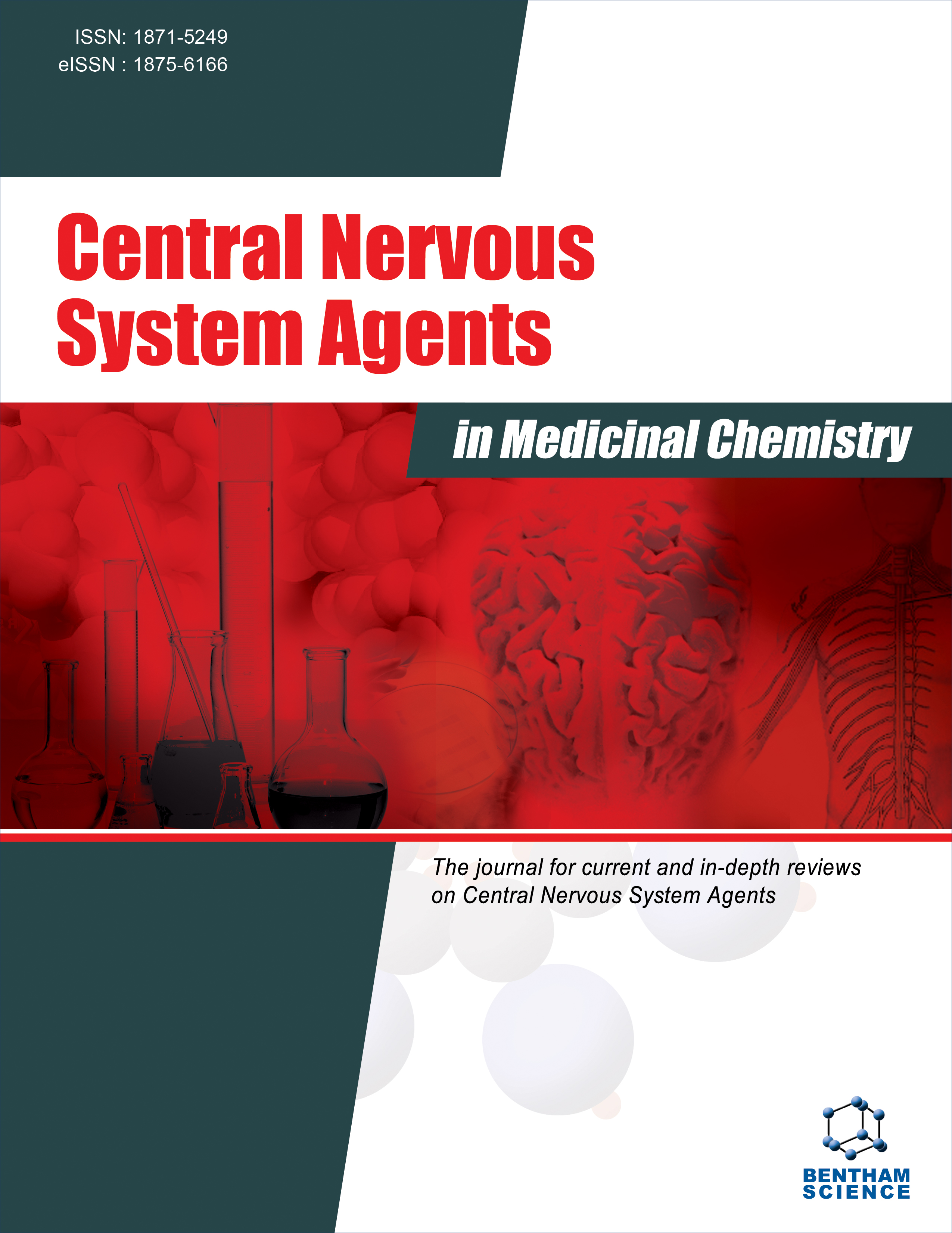- Home
- A-Z Publications
- Central Nervous System Agents in Medicinal Chemistry (Formerly Current Medicinal Chemistry - Central Nervous System Agents)
- Previous Issues
- Volume 8, Issue 4, 2008
Central Nervous System Agents in Medicinal Chemistry (Formerly Current Medicinal Chemistry - Central Nervous System Agents) - Volume 8, Issue 4, 2008
Volume 8, Issue 4, 2008
-
-
Neuroactive Molecules in the Brains of Nonhuman Primates and Their Therapeutic Application to Neurodegenerative Disorders
More LessThe central nervous system (CNS) is more complex in primates, including humans, than in other mammals. Primates have particularly larger, visual, prefrontal, parietal, and temporal cortices. This expansion may cause the higher visual and learning abilities. Furthermore, transient increases in axons and synapses are unique characteristics in the primate neocortex during development. To understand these processe Read More
-
-
-
Cefepime-Induced Neurotoxicity
More LessCefepime is a parenteral fourth-generation cephalosporin antibiotic with an extended spectrum of antimicrobial activity, active against many grampositive and gram-negative bacteria, including Enterobacteriaceae, Pseudomonas aeruginosa, and Staphylococcus aureus. It is excreted primarily unchanged in the urine, its half-life is 2 hours in normal renal function, increasing to 13.5 hours as renal function declines. Dos Read More
-
-
-
Transcranial Magnetic Stimulation in Clinical Pharmacology
More LessAuthors: Dimitrios Kapogiannis and Eric M. WassermannTranscranial magnetic stimulation (TMS) is a safe and easy technique for stimulating neurons in the human central nervous system. Studies combining TMS with drugs in healthy subjects and patients have advanced our knowledge of how TMS activates brain circuits and led to new techniques for evaluating the function of specific systems. For example, TMS techniques can detect effects on axon membranes, glutam Read More
-
-
-
Mechanism of CNS Drugs and their Combinations for Alzheimer's Disease
More LessAuthors: Roongpetch Keowkase and Yuan LuoAlzheimer's disease (AD) is a progressive neurodegenerative disorder. To date, there is no cure for this disease. The FDA approved drugs, cholinesterase inhibitors (tacrine, donepezil, rivastigmine, galantamine) and an N-methyl-Daspartate receptor antagonist (memantine) for the treatment of AD are symptomatically effective to some patients for short periods of time. Cholinesterase inhibitors exert additional phar Read More
-
-
-
Challenge and Therapeutic Studies Using Alpha-Methyl-para-Tyrosine (AMPT) in Neuropsychiatric Disorders: A Review
More LessAuthors: Oswald J.N. Bloemen, M. B. de Koning, E. Boot, J. Booij and T.A. M.J. van AmelsvoortAlpha-methyl-para-tyrosine (AMPT) temporarily inhibits tyrosine hydroxylase, the rate limiting step in the dopamine biosynthesis cascade. AMPT has been approved for clinical use in phaeochromocytoma in 1979. Recently however, AMPT has been increasingly employed as a pharmacological challenge in acute dopamine depletion studies including neuroimaging studies. The use of this exciting challenge technique allows us to i Read More
-
-
-
Schizophrenia and Idiopathic Unconjugated Hyperbilirubinemia (Gilbert's Syndrome)
More LessAuthors: Tsuyoshi Miyaoka, Rei Wake, Maiko Hayashida and Jun HoriguchiIdiopathic unconjugated hyperbilirubinemia (Gilbert's syndrome, GS) is a relatively common congenital hyperbilirubinemia occurring in 3-7% of the world population. It has been recognized as a benign familial condition in which hyperbilirubinemia occurs in the absence of structural liver disease or hemolysis, and the plasma concentration of conjugated bilirubin is normal. Recently, it was reported that uncojugated bilirubin had ne Read More
-
-
-
Melatonin and Its Therapeutic Potential in Neuroprotection
More LessAuthors: Charanjit Kaur, V. Sivakumar and E. A. LingMelatonin, a neurohormone synthesized and secreted by the pineal gland, has antioxidant, immunoregulatory and neuroprotective actions. Production of melatonin is regulated by light and darkness, light decreasing whereas darkness increasing it. Production of melatonin is also known to decline in old age and under hypoxic-ischemic conditions. Melatonin is considered as body's chronological pacemaker and has a wide Read More
-
-
-
Growth Hormone/Insulin-Like Growth Factor-I Axis and Insulin in Alzheimer's Disease and Its Possible Treatment Usefulness
More LessAlzheimer's disease (AD) is a progressive neurodegenerative disorder characterized by insidious onset with cognitive impairment; affects mental function, and is of the amnesic type. Neuropathological analysis of AD-affected brains reveals extensive atrophy and an accumulation of neurofibrillary tangles. AD is a major public health issue in the ageing population and for decades, researches focused on studies using n Read More
-
-
-
The Role of Vasopressin in Affective Disorders: Possible Targets of Intervention
More LessBy Dora ZelenaThe therapy of mood and anxiety disorders are not solved, yet, because current antidepressants have delayed onset of therapeutic action and a significant number of patients are non-responsive. Research on the field was leaning towards neuropeptides as therapeutic targets. The neurohypohyseal hormone vasopressin (VP) is a hot candidate, as beyond its peripheral actions VP is also implicated in interneuronal co Read More
-
-
-
New Proposals for Treatment Sporadic Alzheimer's Disease
More LessAuthors: Ryszard Pluta and Marzena UlamekPatients with sporadic Alzheimer's disease develop a progressive dementia in adulthood, accompanied by five main changes in the brain: loss of neurons, accumulation of intraneuronal neurofibrillary tangles and development of amyloid plaques and deposition of amyloid in neurovessels and inflammation response. Alzheimer's disease is the major form of dementia and the fourth leading cause of death in aging population. Th Read More
-
Volumes & issues
-
Volume 25 (2025)
-
Volume 24 (2024)
-
Volume 23 (2023)
-
Volume 22 (2022)
-
Volume 21 (2021)
-
Volume 20 (2020)
-
Volume 19 (2019)
-
Volume 18 (2018)
-
Volume 17 (2017)
-
Volume 16 (2016)
-
Volume 15 (2015)
-
Volume 14 (2014)
-
Volume 13 (2013)
-
Volume 12 (2012)
-
Volume 11 (2011)
-
Volume 10 (2010)
-
Volume 9 (2009)
-
Volume 8 (2008)
-
Volume 7 (2007)
-
Volume 6 (2006)
Most Read This Month
Article
content/journals/cnsamc
Journal
10
5
false
en


